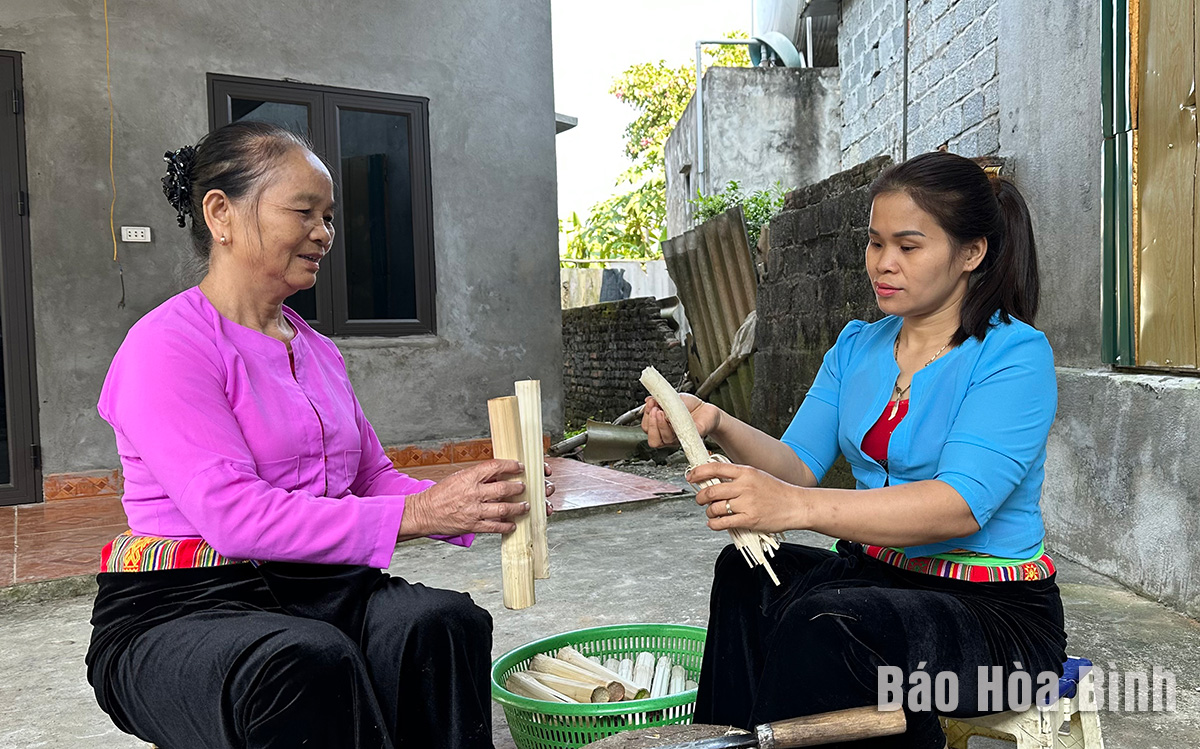
Beyond being a local staple rated as a three-star OCOP product, com lam (steamed sticky rice in bamboo pipes) has been imbued with the culture of the Muong Dong ethnics who believe that com lam is an accomplishment of the locals after a hard working year, and an indispensable delicacy to tickle Tet holiday taste buds.
Photo: Locals in Mo Da residential area, Bo town, Kim Boi district, develop Muong Dong com lam into a three-star OCOP product.
The quintessence of Muong Dong
In order to create the distinctive flavour of com lam, Muong Dong people meticulously select ingredients, with large and milky white glutinous grains preferred. The rice is soaked for about 8-12 hours before being rinsed thoroughly and mixed with a pinch of salt and finely chopped coconut flesh. It is then tightly packed into bamboo tubes and filled with water up to the brim.
As for bamboo tubes, they should be 35-40 centimetres long, cut from fresh and sturdy bamboo trees which are not too old or too young to avoid the rice from drying out or getting burnt.
The rice tubes must be roasted over charcoal between 45 and 50 minutes, and rotated every 15 minutes until they are fragrant.
Com lam could be served with grilled pork, chicken, minced fired pork and pickled bamboo shoots; however, it offered the best taste when paring with muoi vung (minced roasted peanuts, sesame and salt).
According to Dinh Thi Ly, a resident in Mo Da who has considerable experience in making com lam, the secret to making tender and fragrant com lam lies in the glutinous rice grown in mineral-rich water land, and the cook’s experience.
In the Muong customs, men are responsible for preparing meals. However, when it comes to com lam, all people are adept at making it. Com lam has been an integral part of the locals’ daily life and become a unique feature of the Muong culture.
Making com lam reach far and wide
There are currently over 30 households in Mo Da residential area making com lam. To meet market demands, they have worked to improve the production process while still preserving its traditional essence. Along with enhancing product quality, they have focused on improving the product’s packaging and labelling them with origin-tracing stamps. Besides, all products are vacuum-sealed for better preservation. Currently, Muong Dong com lam is served at restaurants and put on sale at supermarkets in many provinces and major cities nationwide.
Pham Hong Son, an owner of Muong Dong com lam production establishment, said his family sells up to 8,000 com lam tubes each month to the market, each valued at 7,000-8,000 VND (0.29-0.33 USD).
As part of the efforts to develop the brand of Muong Dong com lam, locals want to set up a cooperative to gradually complete procedures to develop geographical indication, further improve product quality, and expand market for the staples, he added.
Com Lam not only enriches the culinary culture of the Muong Dong people but also contributes to promoting the Muong culture to tourists and those interested in exploring the traditional cuisine. The lives of the people in Muong Dong have undergone many changes, but com lam remains an indispensable traditional dish, and a gift that is spotlighted at festivals, fairs, and events.
Phong Phu commune, Tan Lac district of Hoa Binh province, is widely regarded as the cultural heartland of the Muong ethnic group. Among its many traditional communities, Luy Ai hamlet (formerly Ai hamlet) stands out as a rare location where the customs and way of life of the Muong Bi people remain largely intact.
The Truong Kha temple festival, a distinctive cultural event held every three years in Vu Ban township, Lac Son district, returned recently with vibrant rituals and folk traditions of the Muong people. Located next to the Buoi River in the Muong Trao fields, the Truong Kha Temple is dedicated to the three Kun Dol deities, revered for teaching farming techniques, irrigation, weaving, and protecting the harvest.
The demand for spaces serving community activities of residents in various areas across Hoa Binh city has been satisfied as local cultural houses now feature modern, spacious facilities thanks to the effective implementation of Resolution No. 49/NQ-HDND issued on December 28, 2021 by the city People's Council, which approved the plan for reorganising, converting, and allocating land for the construction, repair, and expansion of cultural houses in Hoa Binh’s villages and residential areas until 2025.
At the end of May, the Hoa Binh Provincial Ethnic Arts Troupe organized a series of performances for residents in Region 2 and Region 3 communes across the province. Bringing art to ethnic communities in remote, isolated, and especially disadvantaged areas has become a meaningful activity. These are not merely artistic performances but also journeys to disseminate cultural values, enrich spiritual life, and contribute to preserving the cultural identity of ethnic minorities.



